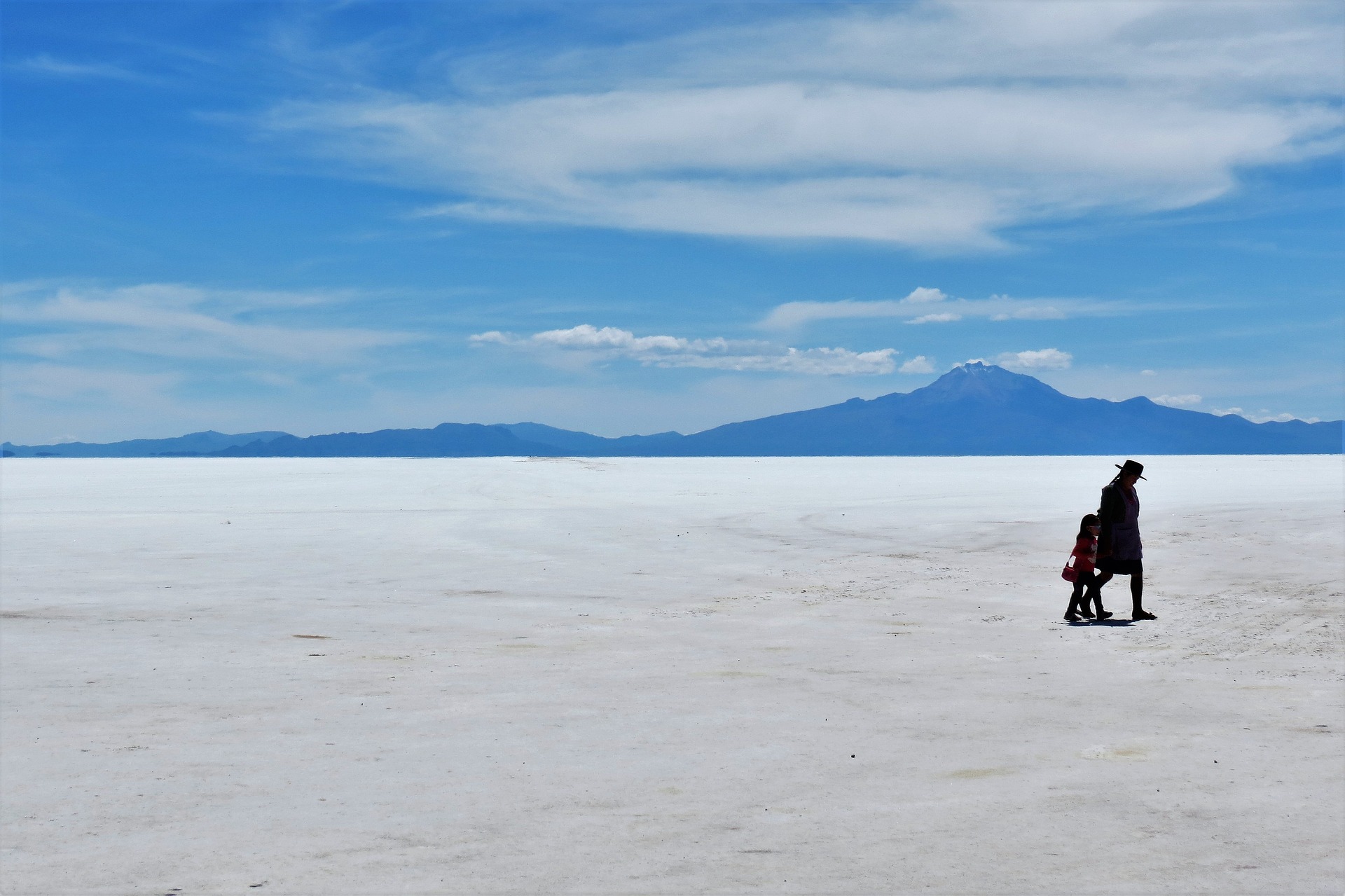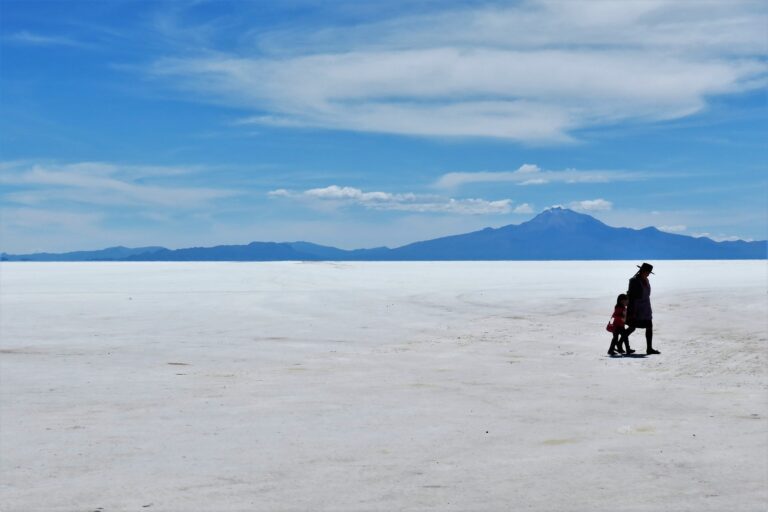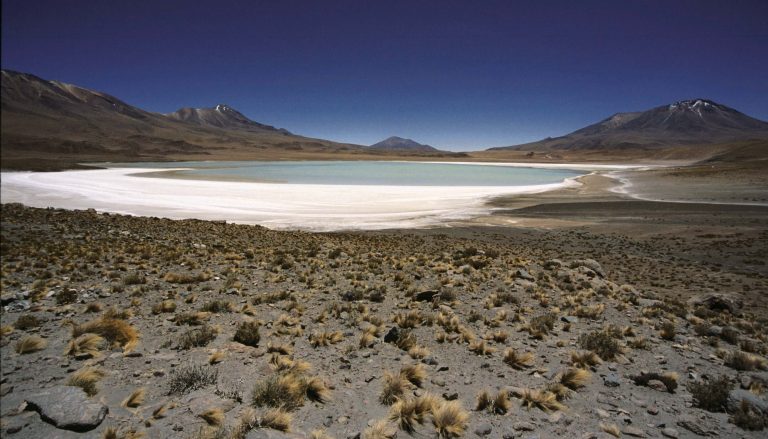Discovering the «Salar de Uyuni» in Bolivia. World’s largest salt flat (2023).
Contenido
Uyuni salt flats facts
The «Salar de Uyuni» (salt fat), located in Potosi Bolivia, is the world’s largest salt flat, covering an area of approximately 10,582 square kilometers. It is situated at an altitude of 3,656 meters above sea level and is surrounded by the Andes Mountains, making for a stunning and unique landscape. The flat is composed of a layer of salt that ranges from several meters to a few tens of meters deep and creates a flat, almost featureless expanse of white that is unlike any other place on Earth.
It was formed as a result of prehistoric lakes that evaporated, leaving behind a vast expanse of blindingly white salt crust that reflects the sky and clouds, creating an otherworldly landscape. The Uyuni Salt Flat is also home to unique flora and fauna, including pink flamingos, and is a popular destination for travelers and photographers seeking breathtaking scenery and surreal experiences.
Weather. Uyuni salt flats best time to visit.

The weather is dry and cold, with temperatures varying between 0 and 20 degrees Celsius during the day and can drop to -20 degrees Celsius at night. The region is very windy and can be difficult to bear for those not used to cold temperatures and dry climates.
The Uyuni salt flat is located on a high plain in the Bolivian Andes, so it is also subject to temperature changes due to altitude and lack of oxygen.
The hottest time of the year is from December to March, while the coldest time is from July to September. During the winter months, it is common for the surface of the salt flat to be covered with snow, which increases its beauty and gives the region a unique and impressive landscape.
It is important to be prepared for weather conditions and bring proper clothing and equipment to protect yourself from the cold and wind. It is also advisable to bring enough water and food, as well as medications to combat the symptoms of altitude, such as headaches and dizziness.
Main tourist attractions at the Uyuni salt flat
Is a popular tourist destination for its spectacular scenery and tourist attractions, some of which include:
- Water mirrors: During the rainy season, the surface of the salt flat becomes a mirror of water that reflects the sky and the surrounding mountains.
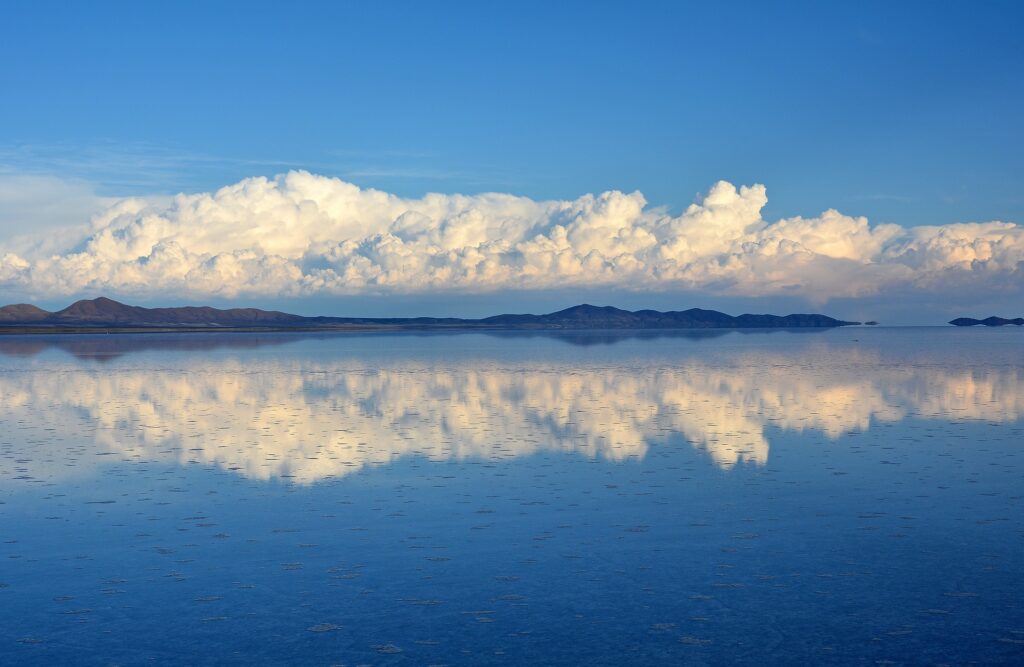
- Salt Dunes: The salt dunes are impressive and offer a great opportunity for photographs.
- Cactus Islands: In the center of the salt flat are several islands that are covered with giant cactus and some unique animals.
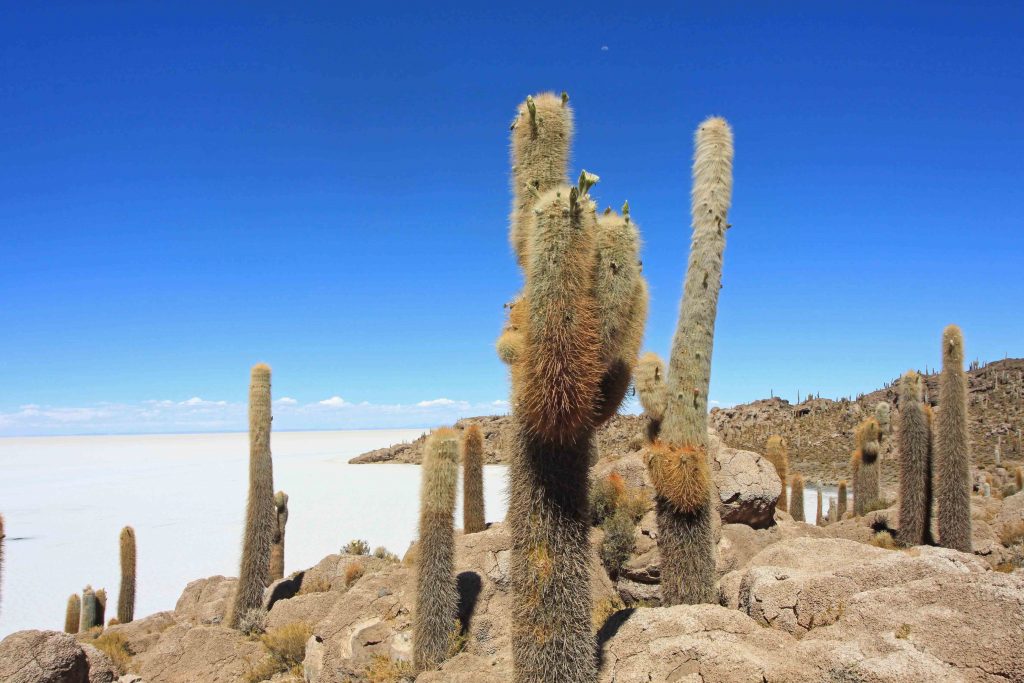
- Volcanoes: The Uyuni salt flat is located at the foot of several active volcanoes, offering a breathtaking view of the Andes mountain range.

- Salt Hotel: The Hotel de Sal, built entirely of salt, is a popular place for tourists looking for a unique experience.
- Salt Museum: The salt museum at the entrance of the salt flat provides information about the geology and history of the salt flat.
- Nearby towns: the nearby towns on the edge of the salt flat, such as Colchani and Incahuasi
Other attractions near Uyuni salt flat
Laguna Colorada (Red lagoon)
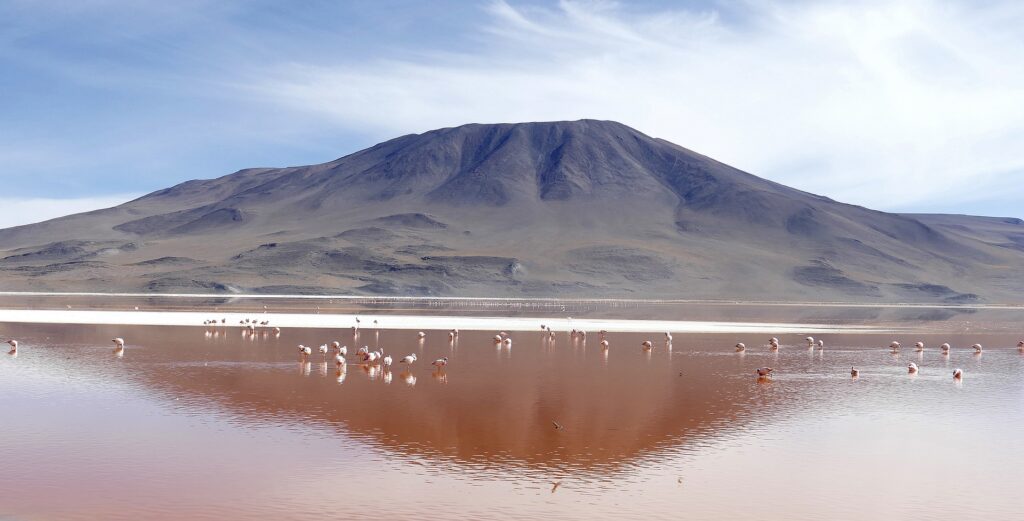
Laguna Colorada (red lagoon) is a saltwater lagoon in Bolivia, located in the Potosí region. It is known for its intense reddish color, which is due to the presence of algae and bacteria that provide food for the fish and flamingos that inhabit the lagoon.
It is a popular tourist destination and is a common part of tours to the Uyuni salt flat. Visitors can admire its unique color and see the colonies of pink flamingos nesting on the shores of the lagoon.
In addition to its natural beauty, Laguna Colorada is also important for the region’s biodiversity, as it is a critical habitat for many species of birds, fish and other animals. Therefore, it is important to follow the guidelines and recommendations of the guides and respect the environment during the visit.
It is important to note that Laguna Colorada is located in a remote area and that the weather can be difficult, with cold temperatures and strong winds. Therefore, it is necessary to be prepared for weather conditions and bring proper clothing and equipment to protect yourself from the cold and wind.
Valle de de la Luna (Moon valley)
«El Valle de la Luna» is a tourist place in Bolivia, located in the Potosí region, near the Uyuni salt flat. It is so named because of its lunar and surreal landscape, with large salt and white sand formations that look like hills and mountains.
Is a popular destination for travelers visiting the Salar de Uyuni, and offers a unique and often surreal experience. Visitors can explore the landscape, take photos and enjoy the view of the lunar landscape.
It is important to note that El Valle de la Luna is a fragile ecosystem and that visitors should respect the environment and follow the guidelines and recommendations of the guides. It is also important to bring enough water and food and be prepared for weather conditions, as the weather can be difficult and the landscape can be inhospitable.
Fishing islets
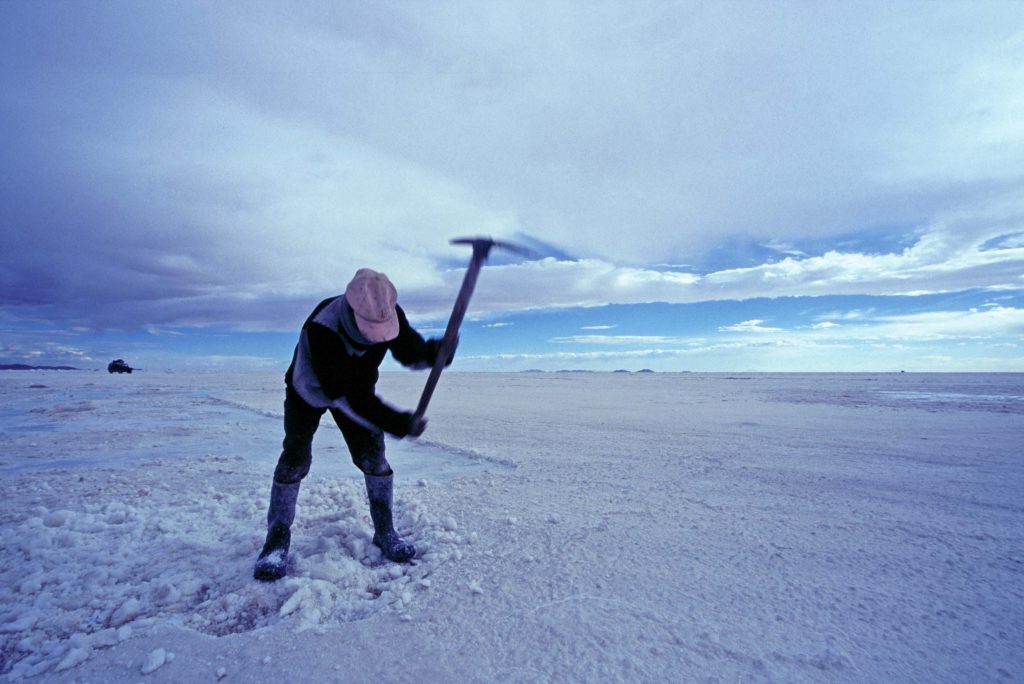
The Islotes de Pescadores are a group of small floating islands in the Uyuni salt flat in Bolivia. These islands are made up of thick layers of salt and are home to local fishing communities who depend on the salt flat for their livelihood.
The Islets of Pescadores are a popular destination for travelers visiting the Uyuni salt flat, and offer a unique and often magical experience. Visitors can explore the islands, meet local communities and learn about their way of life and culture.
How to get to the Salar de Uyuni (salt flat)
There are several ways to get to the Uyuni salt flat in Bolivia:
- Plane: The fastest way is to fly to the city of Uyuni, which has an airport with daily flights from La Paz and other major destinations in Bolivia.
- Bus: It is also possible to reach the Salar de Uyuni by bus from cities such as La Paz, Cochabamba and Potosí. The journey can be long, but it’s an inexpensive way to get to the destination.
- Rental car: Another way to get to the Salar de Uyuni is in a rental car, which will allow you to travel on your own and at your own pace.
Once you arrive in Uyuni, you can hire an organized tour to visit the Salar de Uyuni and explore its surroundings. There are many local tourism agencies that offer day or multi-day tours.
It is important to note that the Salar de Uyuni is located in a remote area and is a tourist destination that requires good planning and preparation. It is advisable to travel with a reliable tourism agency and take measures to protect your health and safety during the trip.
Tours to the Salar de Uyuni
There are many local tourism agencies that offer tours to the Salar de Uyuni in Bolivia. Tours usually include transportation from the city of Uyuni, accommodation in hostels or camps in the Salar, and visits to nearby tourist spots, such as the Islotes de Pescadores, Valle de la Luna and Laguna Colorada.
There are different types of tours available, ranging from day trips to multi-day expeditions that include visits to other destinations in the Potosi and Uyuni region.
It is important to choose a reliable tour agency and read the terms and conditions carefully before booking a tour. It is also advisable to bring clothing and equipment suitable for the cold and dry climate of the region, as well as enough water and food.
The Salar de Uyuni is a popular tourist destination and it is important to take steps to protect its ecosystem and preserve its natural beauty for future generations. Therefore, it is important to follow the guidelines and recommendations of the guides and respect the environment during the tour.
Main hotels in the Salar de Uyuni
The Salar de Uyuni in Bolivia is a popular tourist destination and there are several hotels that offer accommodation for travelers. Here are some of the top hotels in the Salar de Uyuni:
- Palacio de Sal – Hotel built entirely of jumps, offers breathtaking views of the salt flat.
- Luna Salada Hotel – Rustic-style hotel with walls and furniture made of salt.
- Hotel de Sal Isla Incahuasi – Hotel with spectacular views of the salt flat and Incahuasi Island.
- Hotel de Sal Jardines de Uyuni – Hotel with landscaped gardens and views of the salt flat.
- Hotel de Sal Altiplano – Hotel with a salt pool and panoramic views of the salt flat.
These are just some of the hotels in the Salar de Uyuni. There are many more options to choose from, depending on the preferences and budget of each traveler.
The Salar de Uyuni in film and television
The Salar de Uyuni has been used in various film and television productions as a setting for impressive scenes. For example, in the movie «Star Wars: Episode VIII – The Last Jedi» the salt flat was used as a location for the creation of a planet with a desert and saline landscape. In addition, in the television series «Doctor Who» the Salar de Uyuni was used as the setting for the episode «Kill the Moon». Other examples include the film «Motorcycle Diaries» and the BBC documentary series «Human Planet». The impressive landscape and the uniqueness of the salt flat make it an attractive location for audiovisual productions.
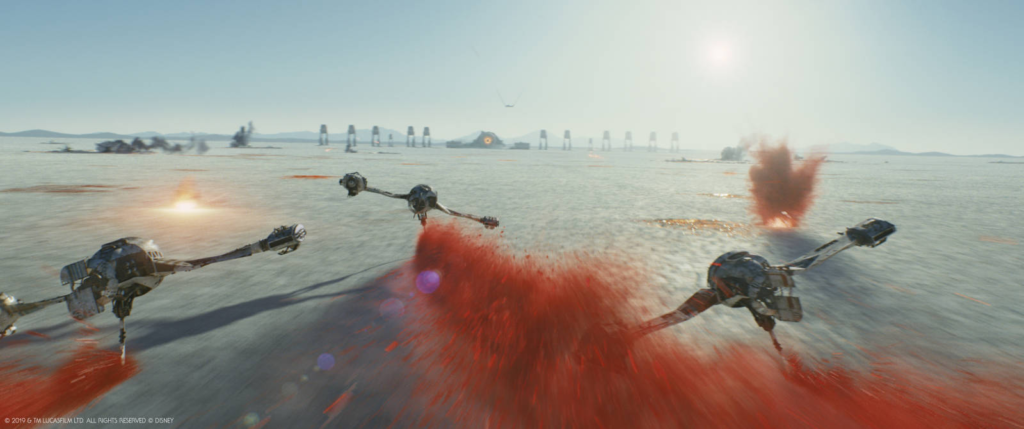
The television series «La Reina del Sur», an adaptation of the homonymous novel by Arturo Pérez-Reverte, also included the Salar de Uyuni as the setting for some of its scenes. In the second season of the series, the protagonist Teresa Mendoza (played by actress Kate del Castillo) travels to Bolivia and meets a group of drug traffickers in the Salar de Uyuni. The scenes in the salt flat were filmed in the area near the lagoons of Cañapa and Hedionda, where you can appreciate the natural beauty of the salt flat and its surroundings. The inclusion of the Salar de Uyuni in the series allowed to show the geographical and cultural diversity of Latin America in a production of international scope.

Otros:
«The Salt of the Earth» (2014) – a documentary about Brazilian photographer Sebastião Salgado.
«Chile, The Last Hope» (2017) – a documentary showing the beauty and ecological importance of the Salar de Uyuni.
«En Tierra de Dios» (2017) – an adventure film that takes place in Bolivia.
Economic potential of the Salar de Uyuni
The Salar de Uyuni in Bolivia is a valuable natural resource with great economic potential. Here are some of the main factors contributing to the economic potential of the Salar de Uyuni:
- Lithium: The Salar de Uyuni is one of the largest lithium deposits in the world, a key element in the manufacture of batteries for electric vehicles and electronics.
- Tourism: The Salar de Uyuni is a popular tourist destination and attracts thousands of visitors every year. Tourism can generate income through tourist services such as guides, transportation and accommodation.
- Salt: Salt is a commodity that is extracted from the Salar de Uyuni and is used in the food and chemical industry.
- Water: The Salar de Uyuni is a source of groundwater that can be used for agriculture and other uses.
These are just some of the factors that contribute to the economic potential of the Salar de Uyuni. However, it is important to note that the exploitation of natural resources can also have negative impacts on the environment and local society, so it is necessary to address these challenges responsibly
Safety first. Factors to consider if you want to visit the Salar de Uyuni
The Salar de Uyuni is a popular tourist attraction in Bolivia, but it also presents some risks. Here are some of the most common risks to consider when visiting the Salar de Uyuni:
- Climate: The weather in the Salar de Uyuni can be difficult, with strong winds, rain and fog. It is important to be prepared for weather conditions and bring enough water and food.
- Road conditions: Roads leading to the Salar de Uyuni can be dangerous and in poor condition, especially during the rainy season. It is important to travel with an experienced driver and a suitable vehicle.
- Altitude: The Salar de Uyuni is at an altitude of 3,656 meters above sea level, which can cause symptoms of altitude sickness in some people. It is important to allow a period of acclimatization before visiting the salt flat.
- Environmental protection: The Salar de Uyuni is a fragile ecosystem and it is important to respect the environment and follow the guidelines and recommendations of the guides.
- Safety: As with any tourist destination, it’s important to take basic safety precautions, such as being careful with valuables and traveling with a group.
It is important to research and prepare properly before visiting the Salar de Uyuni, and follow the recommendations and guidelines of guides and tour operators

